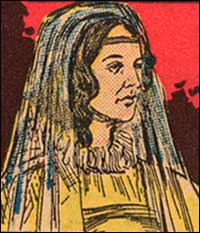Biography of Jane Porter

Jane Porter (1776 -1850)
WE ARE TOLD that Jane Porter was less than six years old when lullabies of "Wallace Wight" were sung to her in her Edinburgh nursery; while in the great hall the old serving-man told wondrous tales of the Battles of Bannockburn and Cambuskenneth. Is it any wonder then, that an imaginative child grown into a talented woman should create "Scottish Chiefs"?
If, as it is charged, Miss Porter's descriptions of Wallace’s achievements are exaggerated, it is no exaggeration to say that her book has become an acknowledged masterpiece of English literature.
Generation upon generation has succumbed to the noble bearing and teachings of "the noblest Scot of all" who led the fight against King Edward's invaders.
Miss Porter devoted a good portion of her early life to research for her story which deals with the period of 1296 to 1305 in the histories of England and Scotland. She took the cold facts of history and warmed them with the flame of her genius to a warm, throbbing story describing the intimate lives of her characters.
Carefully sheltered in the green garden of her cottage in Thames-Ditton, Miss Porter was unconscious of her future glory as she wrote the story of medieval war-engines, clashing armies, and besieged castles. Little did she know, in 1809, that her book was to be translated into every language of the continent; that it would be read by kings, queens and princes, and finally invoke the censorship of the great Napoleon himself!
In her precise Mid Victorian manner, Miss Porter expressed polite gratification for the wide acceptance of her "Scottish Chiefs." She wrote of her "grateful sense of the candor with which so adventurous a work from a female pen has been generally received, particularly among the people of her hero's nation-the country in which she first drew the elements of her intellectual life."
Petite, gentle and shy, Jane Porter wrote of war and battle strategy with the genius of a field marshal. She raises the towers of castles and invests them with men of armor with a sure, certain knowledge of medieval history. Again in 1840, after many thousands of copies of her book had come from the press, she wrote a "Retrospective Preface" when an illustrated edition was given to the public. It was in this second preface that Miss Porter told of how the central figures of her novel first appeared before her imagination. Her chief instructress in the Scottish legends was a pious old woman who lived near her home.
So deeply etched in her young mind were the tales of Wallace and his heroic followers that young Jane began her research at a very early age and it was with a great deal of courage that she took her quill in hand to write "Scottish Chiefs." Only Jane Porter's genius made it possible for the skeptical public of her time to accept the work of a "female" writer; only the rich masterpiece of storytelling which "Scottish Chiefs" proved itself to be, has kept this breathless romantic thriller as popular today as it was more than a century ago.
Jane Porter, whose story of the Scottish fight for independence was to make her name a byword in the English speaking world, was born in the year that the American colonies struck for their independence also - 1776. The little girl whose daydreams were of knights and battles when other children played with dolls lived to see her dreams entertain the world. Jane Porter died May 24, 1850.